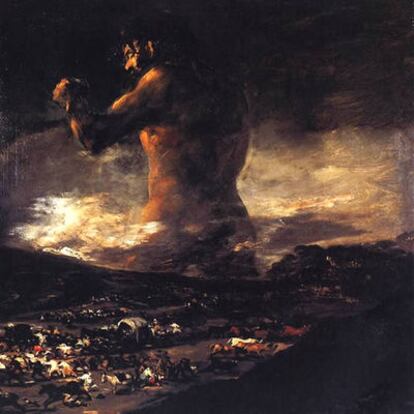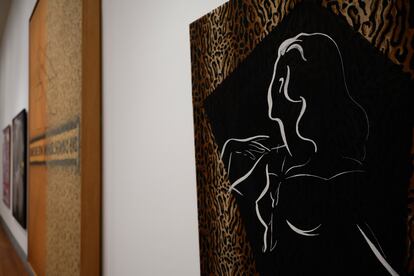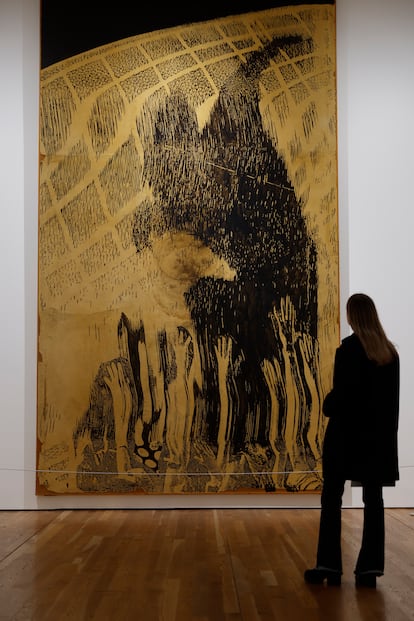Two old and cadaverous women, one blonde and the other brunette, dressed and adorned with luxury, look at each other smugly in a mirror whose back reads: “How are you?” Behind them, the giant Cronos appears armed with a broom ready to sweep the women and turn them into dust because vanity also has its time. Francisco de Goya paints this disturbing scene in The old ones o How are you? (1810-1812), a topic that he had already addressed in the series The Whims. It is a painting, property of the Museum of Fine Arts of Lille, in front of which no one remains indifferent. The German artist Sigmar Polke (Oels, Lower Silesia, East Germany, 1941 – Cologne, Germany, 2010) was able to observe the canvas up close in 1982. He had arrived in the French city with a group of friends and had countless references on the entire Goya’s work and, especially, about The Old Ones. The meeting could not have been more impressive because his work entered new directions. Until then (at 44 years old), his creative interests were multiple.
After the trip to Lille, Goya and his wives began to inspire most of the production of this artist considered a standard of painting. The Prado Museum narrates the consequences of the explosive artistic encounter in the exhibition Sigmar Polke. Affinities revealed which from tomorrow until March 16 can be seen at the Prado Museum. Curated by historian Gloria Moure, the exhibition is produced by the Association of Friends of the Prado in collaboration with the Madrid City Council.
The exhibition occupies rooms C and D of the Jerónimos building and shows more than 40 pieces by the German artist (paintings, photographs and drawings). The central axis of the speech with which the visitor is received is formed by the painting of the Old Women and their X-ray. It is the first time that Goya’s oil painting is exhibited in the Prado. During a tour prior to the presentation of the exhibition, Moure explains that he wanted to show the poetic and political parallelism between both artists. Deep knowledge of this artist’s work, having curated two previous exhibitions: in 1993 at Espai Poblenou and in 2000 at the Fundació Miró.
Moure remembers that Polke was a regular visitor to the Prado Museum since the 1970s and that his meeting in 1982 with The Old Ones of Goya in the Lille museum only confirmed and accelerated his interest in the Aragonese painter, which he had already studied in detail. “For a painter of any century, this museum is a place of reference and study; being able to show his work here was a dream often discussed. As an artist I consider him to be one of the most important painters of the mid-20th century, with great influence on later generations. “It has revitalized the concept of painting from the parameters of contemporary thought.”
Anna Polke, daughter of the artist responsible for disseminating his legacy, was happy with the exhibition at the Prado and recalled that at the beginning of the 80s her father traveled with his partner to Madrid: “He was there for six weeks and every day he went into the Prado. We had long conversations about this museum. “I would be happy.”
The colossus
Regarding the impact of the painting of the mummified elderly women, Polke said in several interviews that the encounter was a discovery more than a surprise. Confirmation of his way of understanding painting. It was not a painting that seemed pretty to him, but he was struck by the pictorial technique of superimposing layers. “What attracted him,” Moure details, “is what he sensed was behind it.”
Pointing out what could be a crack in The old ones, The curator says that behind the hole, the German artist was sure that there was a world full of allegories and fantasies. “He was right because an x-ray revealed the existence of a hidden painting. The oil painting hid a resurrected Christ and a virgin under a sky full of angels. He covered Christ with an image of Saturn/Cronus that dramatizes death on the Catholic divinities. That way of working, with layers upon layers, adds Gloria Moure, is the basis of Polke’s way of painting. The imposing canvas The colossusattributed to Goya until 2018, closes this section of the exhibition.

endless nightmares
The exhibition progresses without chronological order. The themes intersect and the diversity of materials of a creator who was known as an alchemist or a magician of painting is striking. A lover of experimentation, he often used materials such as resin, soot and meteorite dust, as well as photographic images and found objects. In the 1970s he became interested in hallucinogenic drugs and incorporated their visual effects into his art, creating works that were sometimes described as “psychedelic.”

The large canvases are loaded with symbols alluding to the war or the injustice that his family had to suffer. Skulls and swastikas appear again and again like a background of endless nightmare. How would you feel about the threats and drums of war that now threaten the entire world again? “It is difficult to speak for someone who is not there, but it is true that he deeply experienced the consequences of the war and also the fall of the Berlin Wall,” concludes the commissioner. “He was aware of the uncontrollable rise of neoliberalism and its disastrous consequences that could already be seen when he died, 14 years ago. At that time the foundations were being created for a possible growth of the extreme right. The management of fear, the increase in poverty, money as the only value and the lack of culture are elements that we have already known in history and we know where they are going to take us.”

